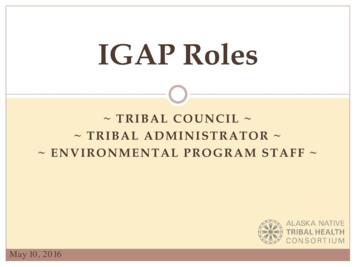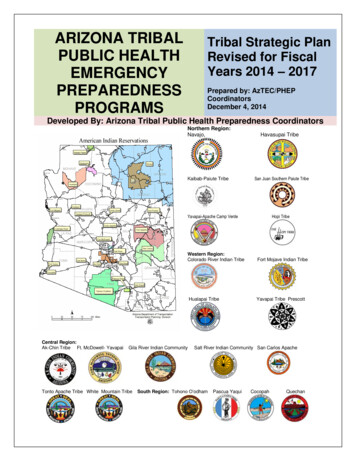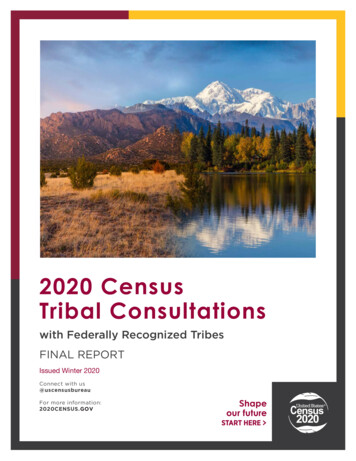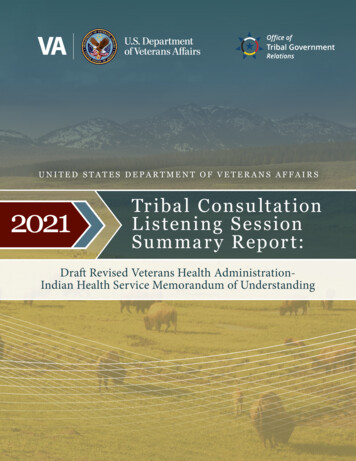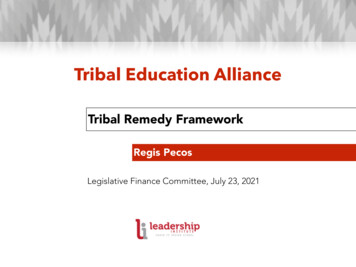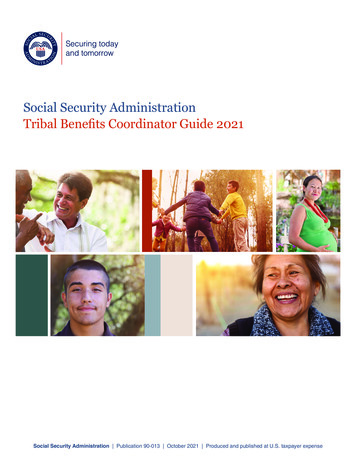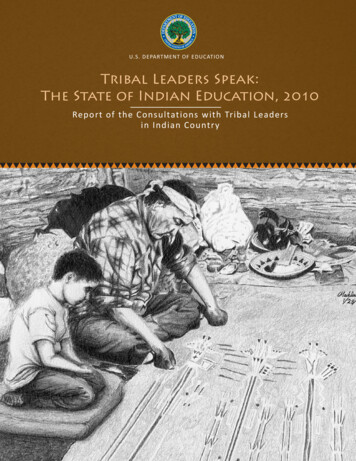
Transcription
U.S. DEPARTMENT OF EDUCATIONTribal Leaders Speak:The State of Indian Education, 2010Report of the Consultations with Tribal Leadersin Indian ssssssssssssss
Tribal Leaders Speak: The State of American Indian Education, 2010Report of the Consultations With Tribal Leaders in Indian CountryU.S. Department of EducationOffice of the SecretaryOffice of Elementary and Secondary Education, Office of Indian EducationWhite House Initiative on Tribal Colleges and Universities
U.S. Department of EducationArne DuncanSecretaryOffice of Elementary and Secondary EducationMichael YudinActing Assistant SecretaryJoyce SilverthorneDirector, Office of Indian EducationWhite House Initiative on Tribal Colleges and UniversitiesWilliam MendozaExecutive DirectorNov. 30, 2011This publication is in the public domain. Authorization to reproduce it in whole or in partis granted. While permission to reprint this publication is not necessary, the citationshould be U.S. Department of Education, Office of Elementary and SecondaryEducation, Office of Indian Education, White House Initiative on Tribal Colleges andUniversities, Tribal Leaders Speak: The State of American Indian Education, 2010;Report of the Consultations With Tribal Leaders in Indian Country, Washington, D.C.,2011.This report is available on the Department’s website ultations.report.pdf
ContentsTribal Leaders Speak: The State of American Indian Education, 2010 . viINTRODUCTION . 1The National Indian Education Study, 2009 . 1The Education System Serving American Indian Students . 2The U.S. Department of Education’s 2010 Plan of Actions . 4Nationwide Consultations With Tribal Leaders in Indian Communities in 2010 . 5AMERICAN INDIANS SPEAK: MANY HISTORICAL CHALLENGES PERSIST . 6American Indians Speak of Failure to Fulfill Historic Trust Responsibility . 6American Indian Leaders Perceive a ―Disconnect‖ Between Federal, State, and LocalGovernments .14American Indians Testify Regarding Insufficient Funding .20American Indians Stress Need to Recruit and Retain Highly Effective Teachers and Leaders.28American Indians Express Need to Collect and Analyze Student Data .33Impact of Poverty and Need for Comprehensive Student Supports .34American Indians Expressed Need for Seamless Cradle-to-Career Pipeline .40CONCLUSION .45Appendix A. Official Consultations and Listening Sessions: Locations and Dates .49
Nov. 18, 2011Dear Tribal Leaders:The Obama Administration is strongly committed to the education of American Indianand Alaska Native people. The President and I believe the future of Indian Countryrests on ensuring that your children receive a high-quality education. Improvingacademic outcomes for Native American children has never been more important.Unfortunately, too many Native American children are not receiving an education thatprepares them for college and career success, too few of them are going to college, andfar too many of them drop out of high school. We need to do better.As Secretary of Education, I have had the privilege of visiting the Northern CheyenneReservation in Montana and the Rosebud Sioux Reservation in South Dakota. Iwitnessed the problems that Indian Country faces with high unemployment, poorhousing, and inadequate school facilities. But the children I talked with on thosereservations gave me hope. They were smart, committed, and passionate. They saidthey want to be challenged. They want to be held to higher expectations.To better serve Native students, we must collaborate with the people who know theirstudents and communities the best—tribal leaders. I have traveled to tribalcommunities in Alaska, Montana, and South Dakota to learn from tribal officials aboutthe challenges their students face. And I sent my senior staff to engage in consultationswith tribal leaders in New Mexico, South Dakota, Oklahoma, Arizona, and Washington.Over the course of our travels, we have had meaningful discussions about thereauthorization of the Elementary and Secondary Education Act (ESEA); the teaching ofNative languages, cultures, and history in our schools; and tribal sovereignty and selfdetermination. This report documents what we heard during those consultations.We also understand that consultations are not an end in themselves. We must followup with meaningful reforms. For instance, as a result of our consultations with triballeaders, we have proposed a new pilot authority in our ESEA reauthorization proposalthat would elevate the role of tribal educational agencies (TEAs). Under this authority,TEAs would work collaboratively with State educational agencies and have a potentiallygreater role in the education of their own children.We are also working on creating a new senior Indian Affairs position at the Department.That appointee will be responsible for ensuring that the educational needs of Nativestudents are met across the Department’s education programs. In policy papers and attribal consultations, tribal leaders and educators talked about the importance of givingtribal communities a voice at the highest levels of the Department.
Finally, the Department administers a number of federal education programs forAmerican Indian students. The Department’s Office of Indian Education, whichimplements the Indian Education programs authorized under Title VII, Part A of theElementary and Secondary Education Act—the only comprehensive piece of federalIndian education legislation—provides funding to meet the unique educational needs ofover 475,000 Indian students in over 1,200 public school districts, as well as studentsattending the schools funded by the Department of the Interior’s Bureau of IndianEducation.I want to assure you that the Department understands its trust responsibility to improveeducational outcomes for all American Indian and Alaska Native students. Thank youfor your leadership. I look forward to working with you further in the years to come.Sincerely,Arne Duncan
Tribal Leaders Speak: The State of American Indian Education, 2010Report of the Consultations With Tribal Leaders in Indian Country
Please let us know what the results of all this is because I've been tomany of these over 40-some years and, in most cases, nothinghappens.—Ivan M. Ivan, Tribal Chief, Akiak Native Community1Together, working together, we're going to make sure that the firstAmericans, along with all Americans, get the opportunities theydeserve.—President Barack Obama2The Department of Education has never, ever engaged in [its own]tribal consultations. . We will prepare a report to the White House andto the Secretary on our conversations here.—Charles P. Rose, General Counsel, U.S. Department of Education31Alaska Consultation, April 16, 2010.White House Tribal Nations Conference, Nov. 5, 2009.3South Dakota Consultation, April 28, 2010.2
INTRODUCTIONWe have to dramatically improve the quality of education in Indiancountry and for Native American students, whether they live onreservations or not.—Arne Duncan, Secretary, U.S. Department of Education4In accordance with President Obama's Nov. 5, 2009, memorandum requiring federalagencies to develop plans of action for consultation and coordination with AmericanIndians/Alaska Natives,5 the U.S. Department of Education conducted six officialconsultations with tribal leaders and American Indian educators across the country in2010. These were the first such sessions that the U.S. Department of Educationsponsored in its history.During the Department of Education’s tribal consultations in Indian communities, triballeaders and educators or American Indian children testified that American Indianstudents face a number of significant challenges, including lack of access to culturallyappropriate curricula, educators without sufficient cultural training, and poor learningconditions. They spoke of organizational challenges, insufficient resources, and limitedopportunities for members of tribal communities to meaningfully participate in theeducation of their own children. These challenges identified by tribal leaders andeducators of American Indian children may act as barriers to a quality education andcontribute to poor outcomes for American Indian students. As data from the 2009National Assessment of Educational Progress (NAEP) show, unfortunately, AmericanIndian students face significant achievement gaps as compared to their non-nativepeers. Tribal leaders testified that these outcomes perpetuate cycles of limitedeconomic opportunity, resulting in significant health, welfare, and justice inequities inIndian country.The National Indian Education Study, 2009It is very important that we hold education important to our children, toour tribal membership, and today is going to be a day where we aregoing to voice our issues and our concerns to the representatives fromthe Department of Education. Because what is being said here todaythey will take back to Washington, and we're hoping that they listen witha good heart and a clear mind, that we are not only expressing what wewant for our education for our children but in the future, a bettereducation.—Theresa Two Bulls, President, Oglala Sioux Tribe64U.S. Department of Education town hall meeting with senior officials, Dec. 15, 2010.For brevity, we use ―American Indian‖ to refer to American Indian and Alaska Native throughout.6South Dakota consultation, April 28, 2010.51
The Department’s NAEP program is the largest nationally representative and continuingassessment of what America's students know and can do in various subjects. Using thedata from the NAEP, the National Center for Education Statistics (NCES) produced theNational Indian Education Study 2009, finding that American Indian student scores inboth reading and math at both fourth- and eighth-grade levels did not improve since2005. In addition, Alaska Natives at the fourth-grade level actually scored lower on thissurvey than in 2005. Specifically, in the 2009 assessment, American Indian studentsattending local public schools lagged behind the general population in reading by anaverage of 17 points out of 500 in fourth grade and by 13 points in eighth grade. As formath, American Indian students averaged 15 points lower than the general population ingrade 4 and 17 points lower in grade 8.American Indian students attending Bureau of Indian Education (BIE) schools faredeven worse in achievement. BIE students averaged 25 points lower in reading than thegeneral population in fourth grade and 23 points lower in grade 8. In math, BIEstudents averaged 20 points lower than the general population in fourth grade and 19points lower in eighth grade.7The Dropout/Graduation Crisis Among American Indian and Alaska NativeStudents8American Indian students also suffer from high dropout rates. For example, in 2008–09,48 states and the District of Columbia reported sufficient data to calculate the AverageFreshmen Graduation Rate (AFGR) by race/ethnicity.9 Across these reporting statesand D.C., the AFGR for American Indian students (64.3 percent) falls between black,non-Hispanic students (63.3 percent) and Hispanic students (65.1); all of which arebelow the rates for whites and Asian / Pacific Islanders (81.5 percent and 92.3 percent,respectively). This dynamic changes somewhat when looking at states where thepercentage of the 2008–09 graduation cohort made up of American Indian studentsexceeds the average percentage of all students in the reporting states who areAmerican Indian (i.e., exceeds 1.25 percent).10 Across these states the AFGR forAmerican Indian students was 62.3 percent. This falls below the rates for black,Hispanic, white, and Asian students across these same states (66.2 percent, 67.0percent, 82.6 percent, and 91.3 percent respectively).The Education System Serving American Indian Students7U.S. Department of Education, Institute of Education Sciences, National Center for Education Statistics,National Assessment of Educational Progress (NAEP), National Indian Education Study 2009.8U.S. Department of Education, National Center for Education Statistics, Common Core of Data (CCD),"NCES Common Core of Data State Dropout and Completion Data File," School Year 2008—09, Version1a.9The AFGR could not be calculated by race/ethnicity in school year 2008-09 for Maine and Nevada.10Alaska, Arizona, Idaho, Kansas, Minnesota, Montana, Nebraska, New Mexico, North Carolina, NorthDakota, Oklahoma, Oregon, South Dakota, Utah, Washington, Wisconsin, and Wyoming all haveAmerican Indian and Alaska Native populations that exceed 1.25 percent of their estimated 2008-09graduation cohort population.2
The complexity of [education] systems is daunting.—Janine Pease, Crow Tribe11During the 2005–06 school year, American Indian students comprised some 644,000public elementary and secondary school students, or about 1 percent of all publicschool students. If regarded as a state student population, American Indian studentswould represent the 27th largest state by student enrollment in the country, comparablein size to such states as Kentucky, Louisiana and Oklahoma. The great majority, some92 percent, of American Indian students attend regular local public schools that fallunder the jurisdiction of pertinent state and local educational authorities.The U.S. Department of the Interior’s BIE schools enroll approximately 8 percent of allAmerican Indian public school students in 184 BIE-funded schools. Sixty-one of theseschools are operated by the BIE and 123 by tribal authorities themselves, either underBIE contracts or with grants. During the 2009–10 school year, BIE schools served46,524 American Indian students. These schools were located on 63 reservations in 23states.12 If treated as its own school district, the BIE would rank, by enrollment, in thetop 100 out of nearly 16,000 school districts in the nation.The responsibility to provide education to American Indian youth is set out in federalstatutes and treaties. Whereas the federal government maintains a unique trustobligation, brokered in the 19th century, which includes responsibility over delivery ofeducation services, state and local authorities are not obligated by these federalstatutes and treaties. As it is with public education generally, much of the discretion asto policies and resources affecting the vast majority of American Indian students—themore than 90 percent who attend regular public schools—is left to the judgment of stateand local authorities, and, therefore, varies by jurisdiction.In addition to the fragmentation that occurs within a federal-state-local educationstructure, there is further fragmentation within the federal agencies. For example, withinthe U.S. Department of Education there are several program offices that implementdifferent programs and initiatives that operate under distinct Departmental authorities.The BIE is located within the Office of Indian Affairs at the U.S. Department of theInterior. The Office of Indian Affairs is one of eight Interior bureaus, including the U.S.Fish and Wildlife Service; the National Park Service; the Office of Surface Mining;Reclamation and Enforcement; the Bureau of Land Management; the Office of OceanEnergy Management, Regulation and Enforcement; and the U.S. Geological Survey.Under the Office of Indian Affairs, the BIE is among several other offices, including theOffice of Indian Energy and Economic Development; the Office of Justice Services; the11Comment card submission, U.S. Department of Education town hall meeting with senior officials,Dec. 15, 2010.12U.S. Department of Education, National Center for Education Statistics, Status and Trends in theEducation of American Indians and Alaska Natives, September lights.asp, accessed March 16, 2011.3
Office of Indian Services; and the Division of Tribal Government Services. 13 The U.S.Department of the Interior employs 70,000 individuals. Of this total, 4,300 are employedby the BIE, approximately the same as the total number employed by the U.S.Department of Education.14The U.S. Department of Education’s 2010 Plan of ActionsAmerican Indian issues today are primarily within the U.S. Departmentof Interior where we compete with animals, trees, rocks, etc.Meeting with U.S. ―people departments‖ is refreshing.—Anonymous, South Dakota consultation comment card submission15Following President Obama's November 2009 memorandum requiring federal agenciesto develop plans of actions for consultation and coordination with American Indian tribalgovernments, the U.S. Department of Education began working with tribal nations andother federal agencies. Department of Education officials, including Senate-confirmedstaff and senior-level office directors, attended seven interagency conferences acrossthe country in Dec. 2009. These included conversations with the Departments ofCommerce and Agriculture and tribal officials, a conference of the National IndianImpacted Schools Association, the South Dakota Indian Education Conference, a U.S.Department of the Interior tribal consultation, and the Department of the Interior, Bureauof Indian Education Safe Schools Summit.These conferences and conversations laid the groundwork for the Department ofEducation’s tribal consultations that followed.On Feb. 3, 2010, Secretary Duncan then submitted to the Office of Management andBudget a Plan of Actions (the Plan) for implementing President Clinton’s 2000 ExecutiveOrder 13175, which was intended to establish regular and meaningful consultation andcollaboration with tribal officials in the development of federal policies that have tribalimplications, to strengthen the United States government-to-government relationshipswith Indian Tribes, and to reduce the imposition of unfunded mandates upon IndianTribes. The development of the Department of Education’s Plan was guided by thefollowing four principles: The U.S. recognizes the right of federally recognized Indian tribes to selfgovernment, and supports tribal sovereignty and self-determination;In general, this right forms the basis of every federal policy or program that hastribal implications;13U.S. Department of the Interior, ―What We Do,‖ http://www.bia.gov/WhatWeDo/index.htm, accessedMarch 18, 2011.14U.S. Department of the Interior, ―Bureaus & Offices,‖ http://interior.gov/bureaus/index.cfm, accessedMarch 18, 2011.15Comment card submission, South Dakota consultation, April 28, 2010.4
Regular and meaningful dialogue is the appropriate vehicle for ensuring that thisright is reflected in federal policies and programs; andThe Department’s role is to ensure that the unique educational and culturallyrelated academic needs of American Indians and Alaska Natives are met.The Plan outlined regular and ad hoc consultations with follow-through; intra-agencycoordination, including the provision of training and formation of working groups;interagency collaboration, particularly with the BIE; and communications and outreachby federal agencies, to forge closer ties between the federal government and tribalcontacts. The Plan designated then General Counsel Charles P. Rose as the seniorDepartmental official in charge of Plan implementation.Nationwide Consultations With Tribal Leaders in Indian Communities in 2010The whole notion of equity is something that has oftentimes not servednative people. It has actually worked against us because we're notnecessarily trying to be the same as all these other groups.—David Iyall, Cowlitz Tribe; University of Washington16As laid out in the Plan, the U.S. Department of Education independently organized, forthe first time in its history, consultations with tribal leaders in Indian communities, onetown hall in Washington, D.C., and two teleconferences between senior Departmentofficials and federally recognized tribal leaders and American Indian educators in 2010.These consultations are documented in court reporter transcripts available on theDepartment’s website, ml). Seniorofficials from the U.S. Department of the Interior’s Office of Indian Affairs alsoparticipated in many of these sessions. The 2010 consultation venues includedAnchorage, Alaska; Espanola, New Mexico; Shawnee, Oklahoma; Pine Ridge, SouthDakota; Window Rock, Arizona; and Puyallup, Washington; conference calls, as well,took place among tribal representatives, Secretary Duncan and other high-levelDepartmental officials. Many of the in-person consultations were held on triballycontrolled lands.During these consultations, representatives of federally recognized tribes and AmericanIndian educators spoke, and Department officials listened and learned.Recommendations and comments generally depicted a challenging scenarionotwithstanding several success stories. The testimony of tribal officials and educatorsof American Indian students is reflected in this report.Among the objectives of these sessions was to seek input from American Indian leadersand educators on critical education issues, including for the reauthorization of theElementary and Secondary Education Act so that policymakers would hear from16Washington consultation, July 15, 2010.5
American Indian leaders and educators on how to revise the law so that it includesmeaningful reform for the education of American Indian students.17AMERICAN INDIANS SPEAK: MANY HISTORICAL CHALLENGES PERSISTAmerican Indians Speak of Failure to Fulfill Historic Trust ResponsibilitySo the funding that you bring towards us we look at this as a partialpayment of the rental of our lands.—Jesse Taken Alive, Tribal Council Representative, Standing RockSioux Tribe18SummaryFederally recognized tribes and American Indian educators expressed outrage atperceived failures of the federal government to fulfill its ―moral obligation of the highestresponsibility and trust‖ to Indian tribes. The federal courts have long recognized thedistinctive obligation of trust incumbent upon the federal government in its dealings withIndian peoples. Under its historic trust responsibility, the federal government mustprotect tribal self-governance, lands, assets, resources and treaty rights, and complywith applicable federal statutes, treaties and court decisions.19The general rationale for this legal relationship has been that the federal governmentwould be permitted to use American Indian tribal lands and other national resources inexchange for the provision of basic services, including health, education, and economicdevelopment to the Indian tribes.20,21 Both trust privileges and service-provisionresponsibilities were to be executed with the ongoing input of tribally affiliated AmericanIndians.22,23,24,2517U.S. Department of Education, ―Plan of Actions for Implementation of Executive Order 13175:Consultation and Coordination with Indian Tribal Governments,‖ Feb. 3, plan-2010.pdf, accessed Jan. 31, 2011.18South Dakota consultation, April 28, 2010.19Seminole Nation v. United States, 316 U.S. 286 (1942).20Snyder Act, 1921.21Treaty of Point Elliot, Jan. 22, 1855.22Canby, Jr., William C., American Indian Law in a Nutshell, 1998, Eagan, Minn.: West Group.23Cohen, Felix S., Handbook of Federal Indian Law with Reference Tables and Index, 1988, Buffalo,N.Y.: William S. Hein & Co.24Pevar, Stephen L., The Rights of Indians and Tribes: The Basic ACLU Guide to Indian Tribal Rights,1992, Carbondale, Ill.: Southern Illinois University Press.25Prucha, Francis Paul, ed., Documents of United States Indian Policy, 2nd ed., 1990.6
While federal treaty obligations continue, adequate oversight, including oversight overeducation programs for American Indian students funded by the federal governmentand channeled through various state, local and tribal authorities, is challenging.Additionally, state and local governments are not required to comply with federal treatyobligations.During the consultations, tribal leaders indicated that their perception of the federalgovernment’s failure to provide quality education services to American Indian students,whether they attend BIE or local public schools, is another instance of the federalgovernment failing to fulfill its trust responsibilities to sovereign American Indian nations.In their comments, American Indian educators and leaders of federally recognized tribesalike attributed this perceived government failure to meet its Indian trust responsibilitiesto a variety of factors, including the complexity of federal, state, local, and tribaleducation systems, a perceived failure of the federal government to consult withAmerican Indians themselves, and, according to those leaders, insufficient anduncoordinated federal funding for Indian education.TestimonyThis responsibility of providing for the education of American Indianpeople is based on the unique status of Indian people and has beenrecognized over time through federal legislation, such as the SnyderAct as well as the Indian Education Act.—Walter Dasheno, Governor, Santa Clara Pueblo26The role of states in upholding trust responsibility must be defined because a majority of Indian youth attend public school.—Tulalip Tribes of Washington State27The U.S. government has a trust responsibility to all the tribes. Andfrom what I've seen, they're partially negligent in that trust responsibility.—Peter Garcia, Ohkay Owingeh28I want to emphasize the fact that education is a treaty obligation ascited in Article 7 of the [1868] Fort Laramie treaty that was establishedbetween our nation and the Congress of the United States of America.The education services that are provided by this treaty provision do notdifferentiate between the U.S. Departments of Education and Interior.—Thomas Conroy, Chairman, Pine Ridge School Board2926New Mexico consultation, May 3, 2010.Written testimony, April 16, 2010.28New Mexico consultation, May 3, 2010.29Written testimony, April 28, 2010.277
Many of those dollars that the states receive are federal flow-throughdollars for the services and so, by way of receiving those federaldollars, those states also buy into that federal trust responsibility.—Mary Jane Oatman-Wak Wak, Nez Perce Tribe; National AdvisoryCouncil on Indian Education; Director, Indian Education, State ofIdaho30This was ours at one time. You've got to understand that there's anobligation. When are we going to quit begging?—David Beaulieu, Lac du Flambeau Tribe, Wisconsin; ProfessorEmeritus, Arizona State University31We concur with President Obama's conviction that the federalgovernment has a trust relationship with all American Indian tribes,including a responsibility for providing educational services to AmericanIndian students, because of the special government-to-governmentrelationship between tribes as sovereign governments and the UnitedStates Government.—Walter Dasheno, Governor, Santa Clara Pueblo32Congress declared its commitment to the maintenance of thefederal government's unique and continuing trust relationship with andresponsibility to the Indian people for the education of Indian childrenthrough the establishment of a meaningful Indian self-determinationpolicy for education that will deter further perpetuation of federalbureaucratic domination of programs.—Noreen Sakiestewa, Director for the Department of Education for theHopi Tribe33American Indians Seek More Tribal Control Over EducationIf we're going to be in control of our destiny, we have to be in control ofour education.—Everett Chavez, Governor, Pueblo of Kewa34SummaryTribal leaders and American Indian educators indicated that state and local authoritiesdo not consult them in meaningful and regular dialogue regarding American Indian30U.S. Department of Education town hall meeting with senior officials, Dec. 15, 2010.Ibid.32New Mexico consultation, May 3, 201033Arizona consultation, June 30, 2010.34New Mexico consultation, May 3, 2010.318
education, resulting in what they view as a loss of control over their children’seducation.TestimonyWe want more local control not only for the Cherokee Nation but ourpublic school districts. They're the ones who know the daily challengesthey face.—Corey Bunch, Cherokee Nation Education Services35We ask that districts be required to include tribal governments whenapplying for grants.—Tulalip Tribes of Washington State36Maybe we could tie into the roles of state funding and make itmandatory that to accept that funding at the state level that theyhave to work with tribal consultation.—Theresa Two Bulls, President, Oglala Sioux Tribe37Modern federal laws like ESEA need to reconnect these schools totribal governments. It's about tribes helping to determine how Title Ifunds can be best used to help tribal students, no matter what thestandards are in their particular state.—Quinton Roman Nose, President, Tribal Education DepartmentsNational Assembly38The states
Education, Office of Indian Education, White House Initiative on Tribal Colleges and Universities, Tribal Leaders Speak: The State of American Indian Education, 2010; Report of the Consultations With Tribal Leaders in Indian Country, Washington, D.C., 2011. This report is available on the Department's website at:

